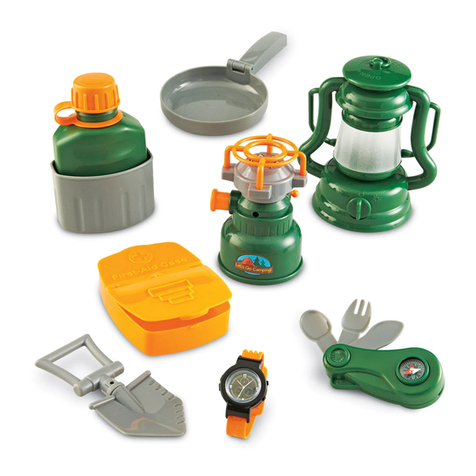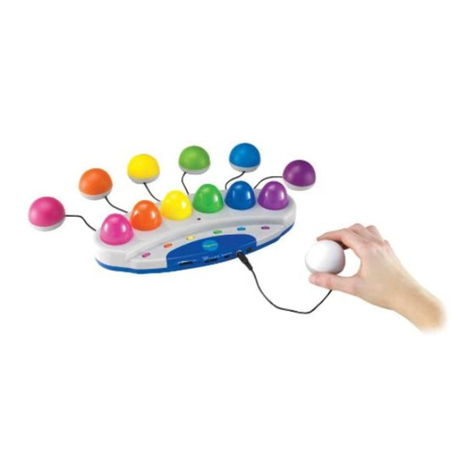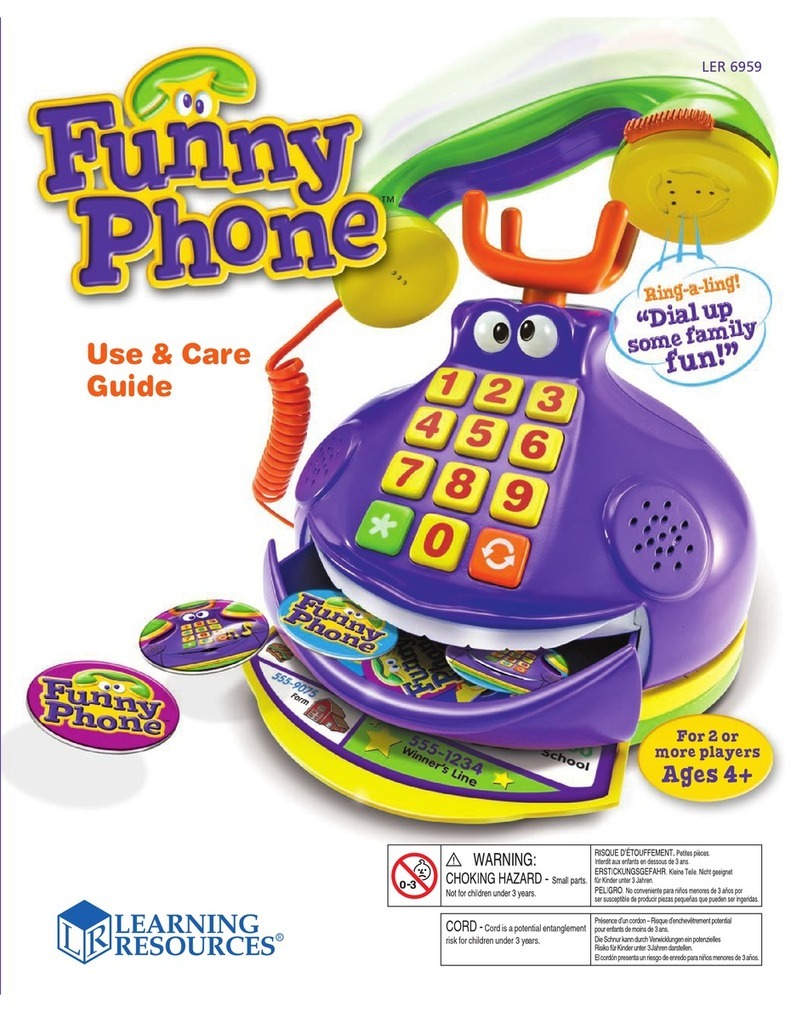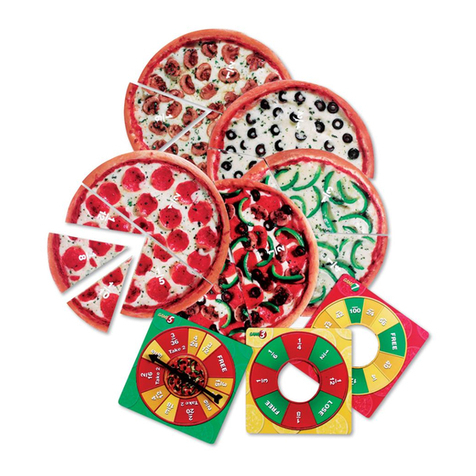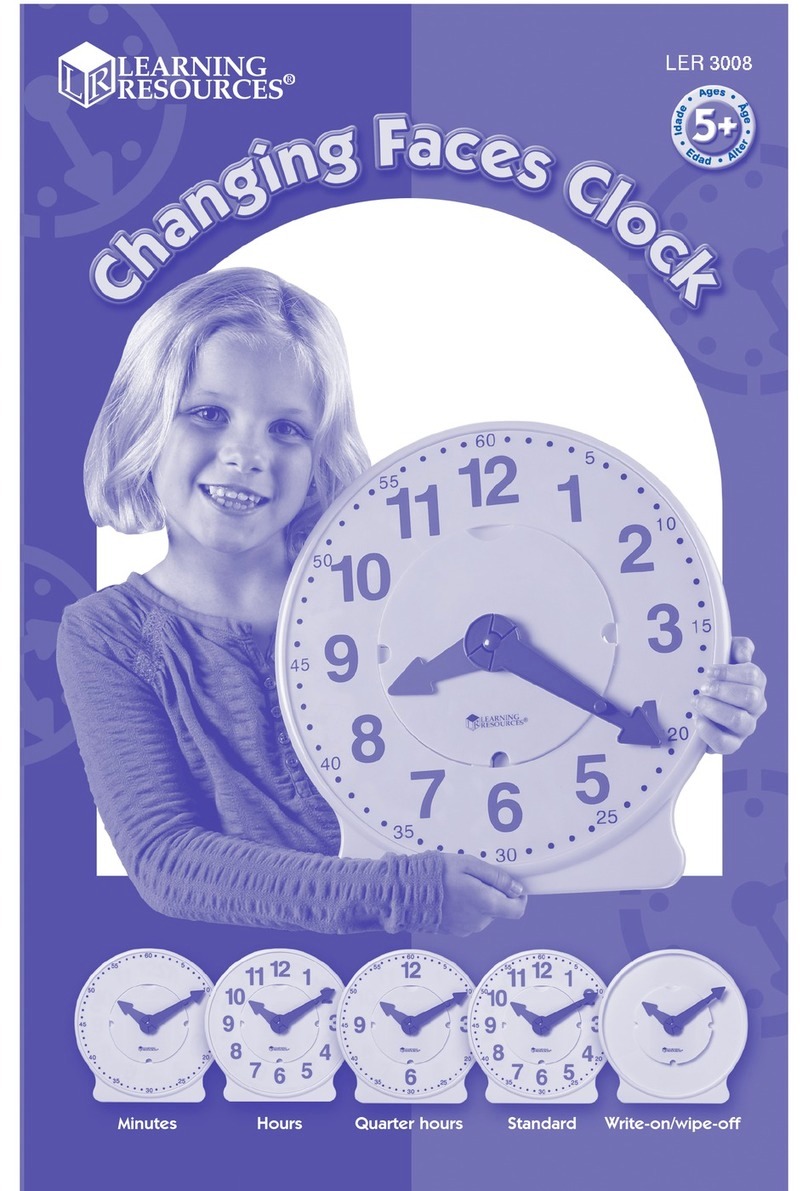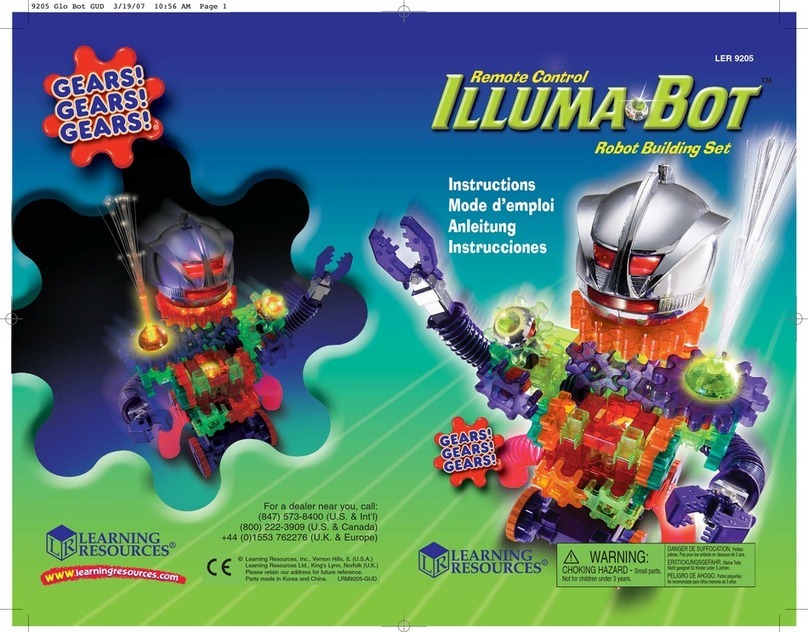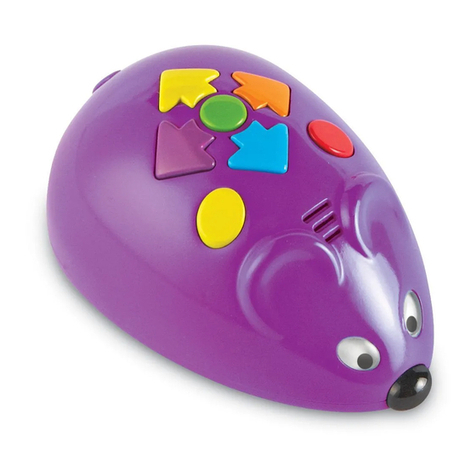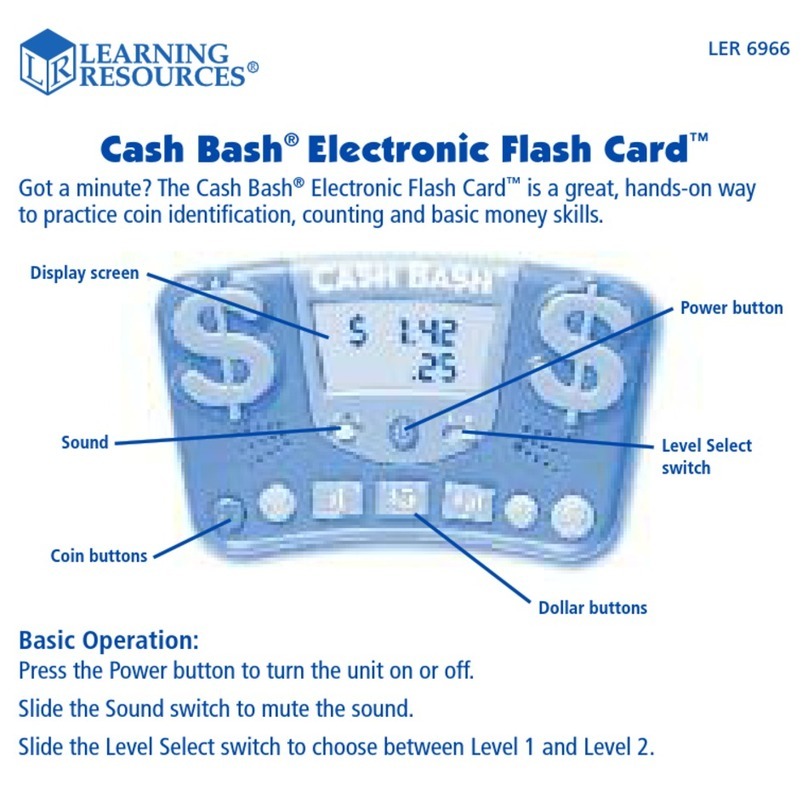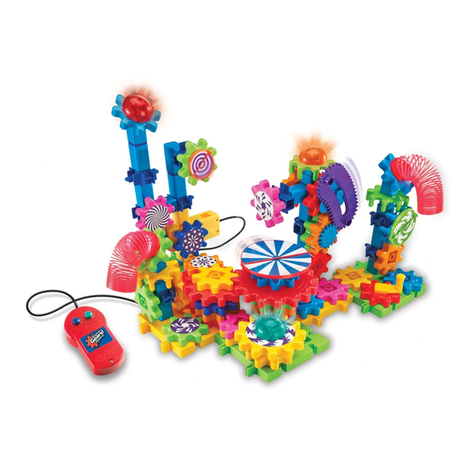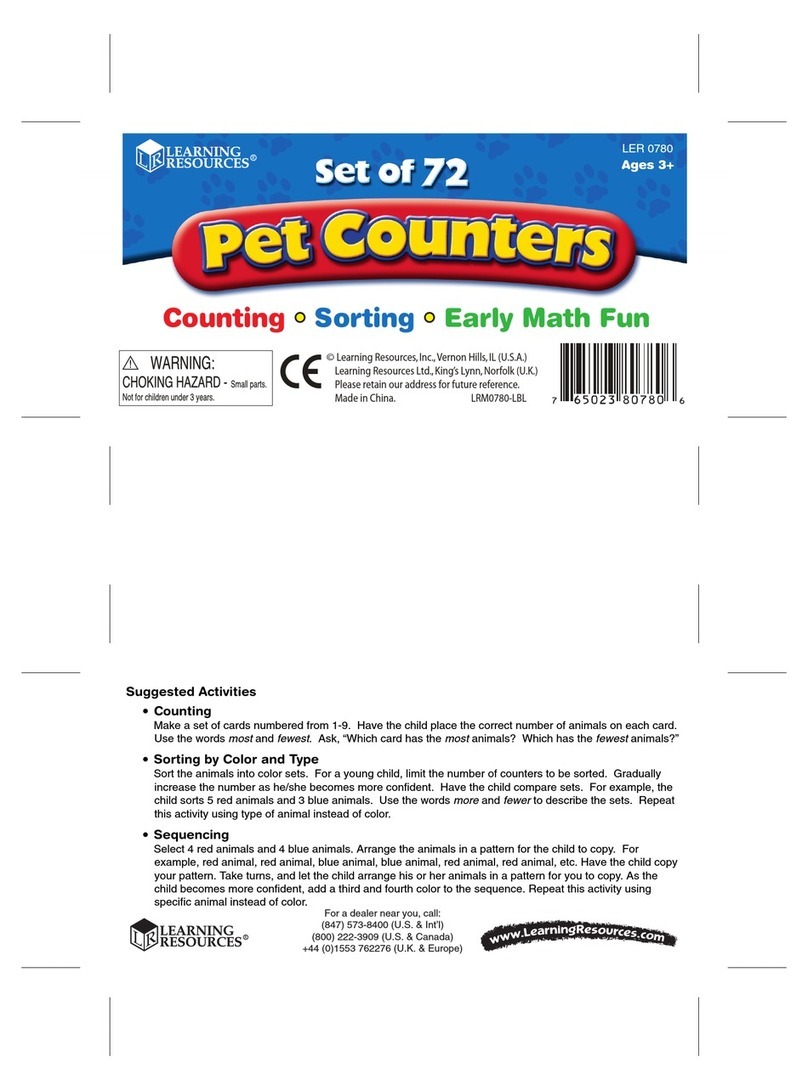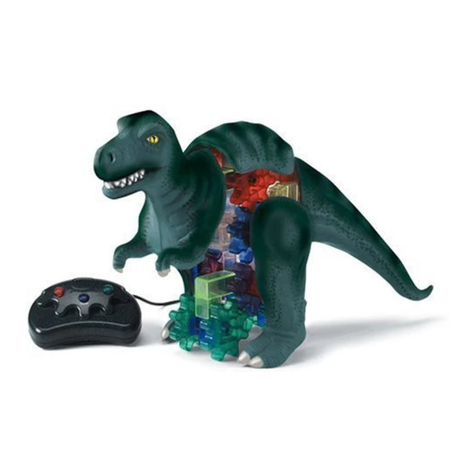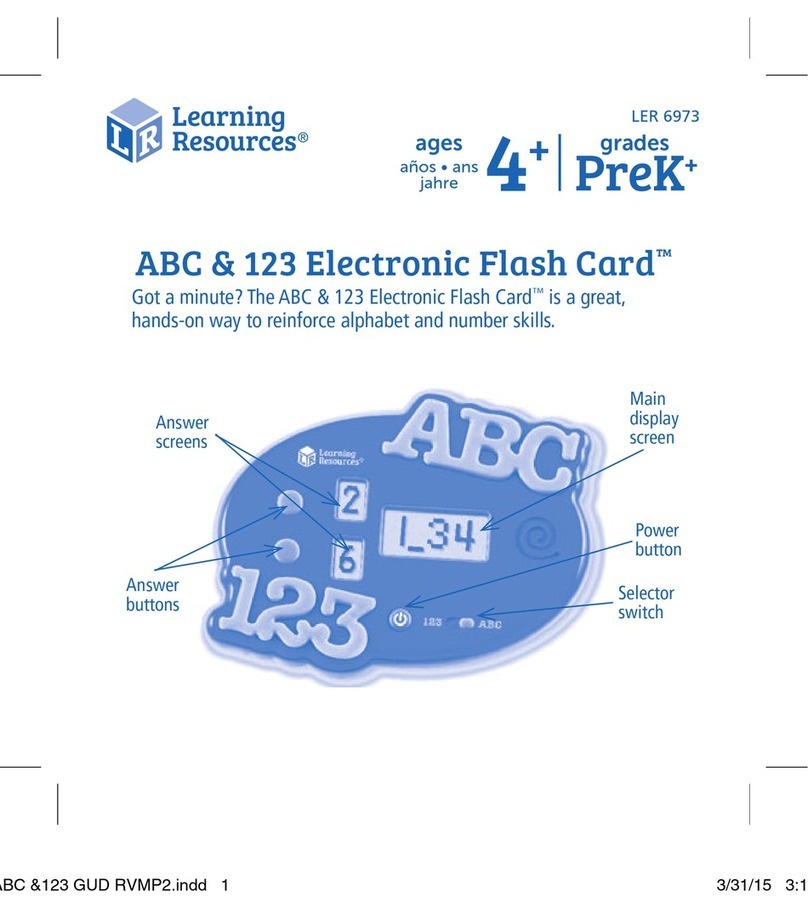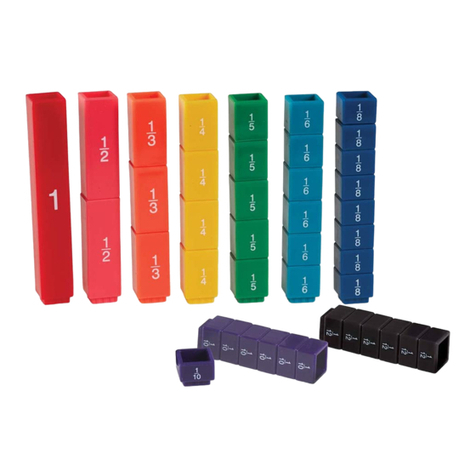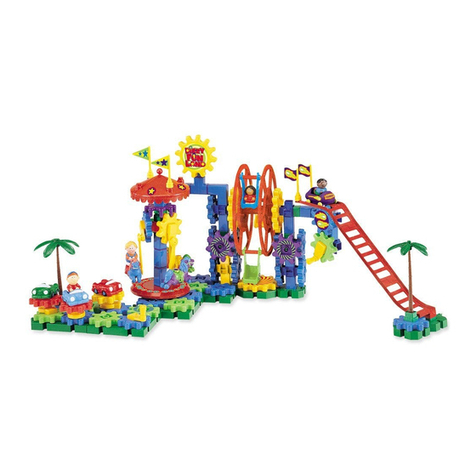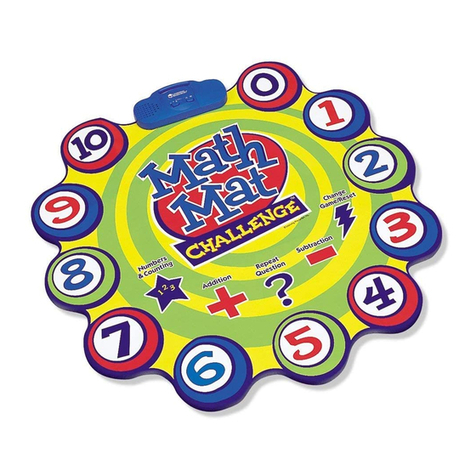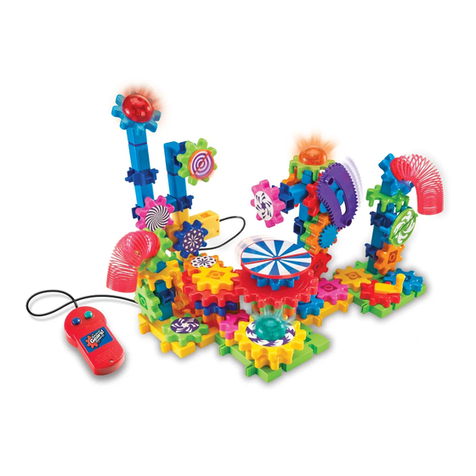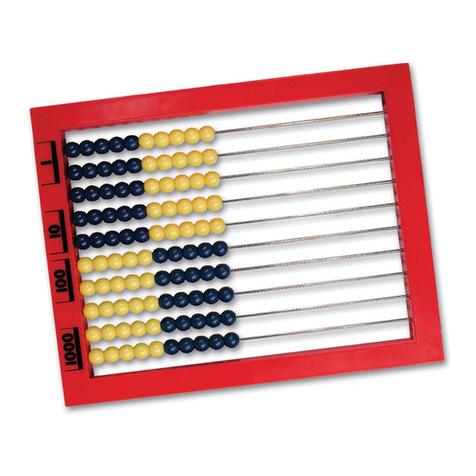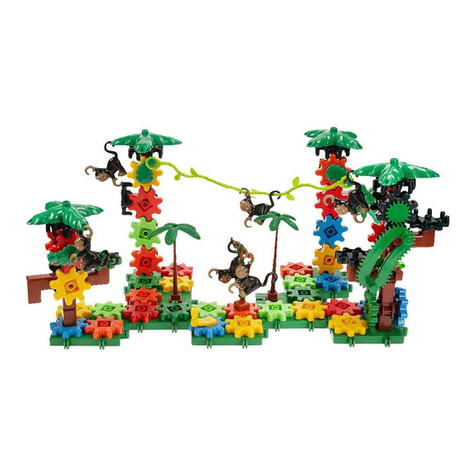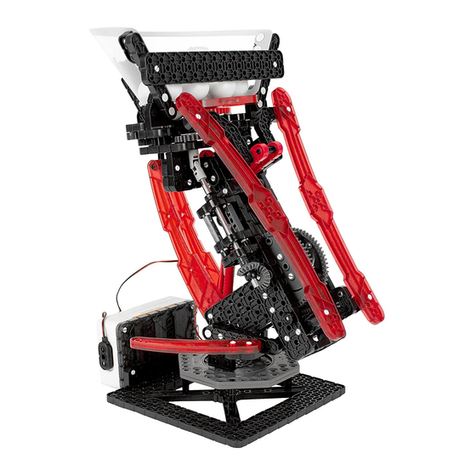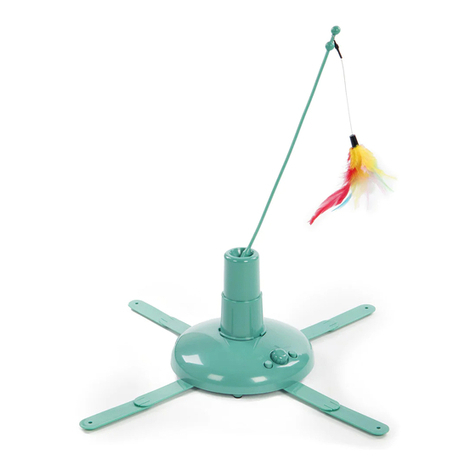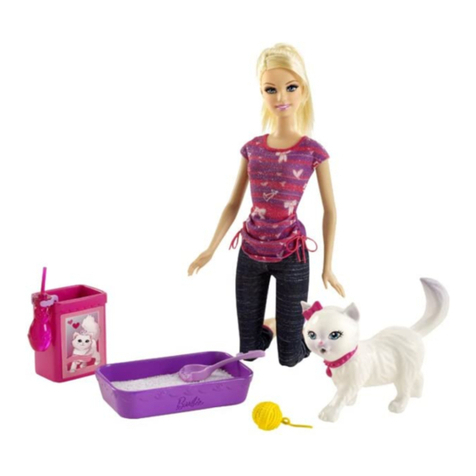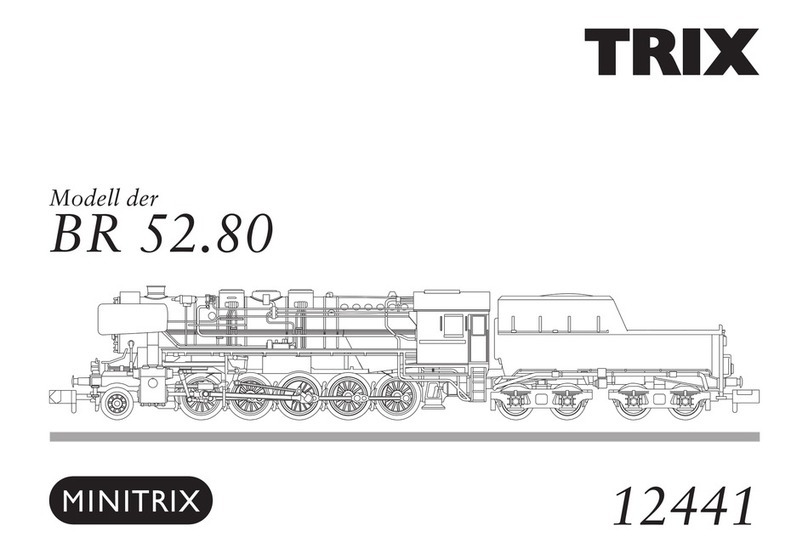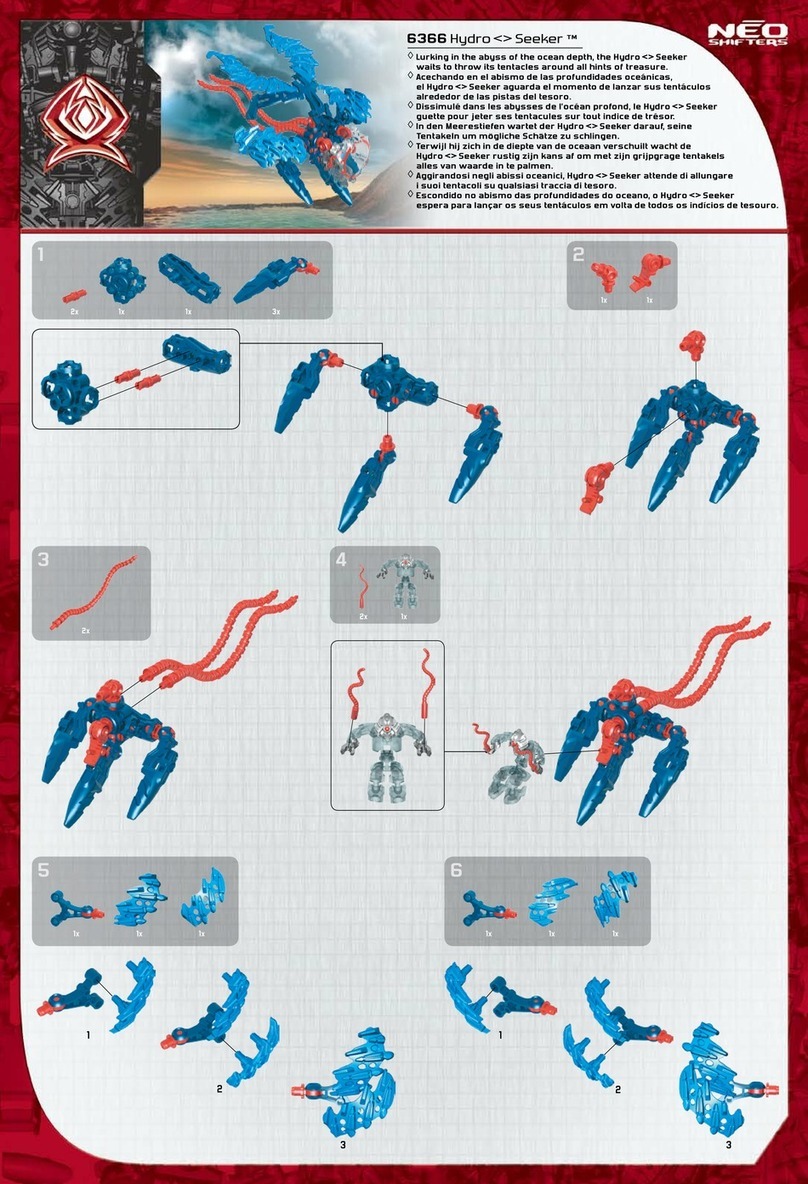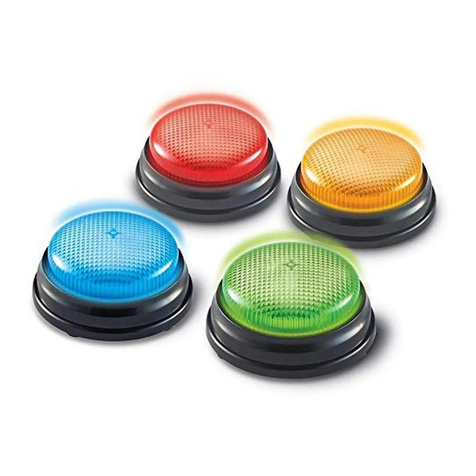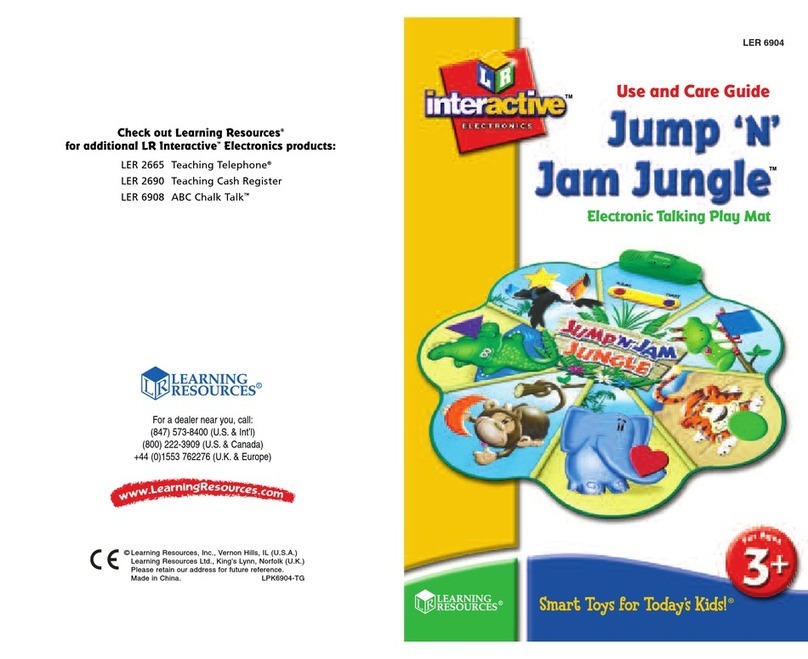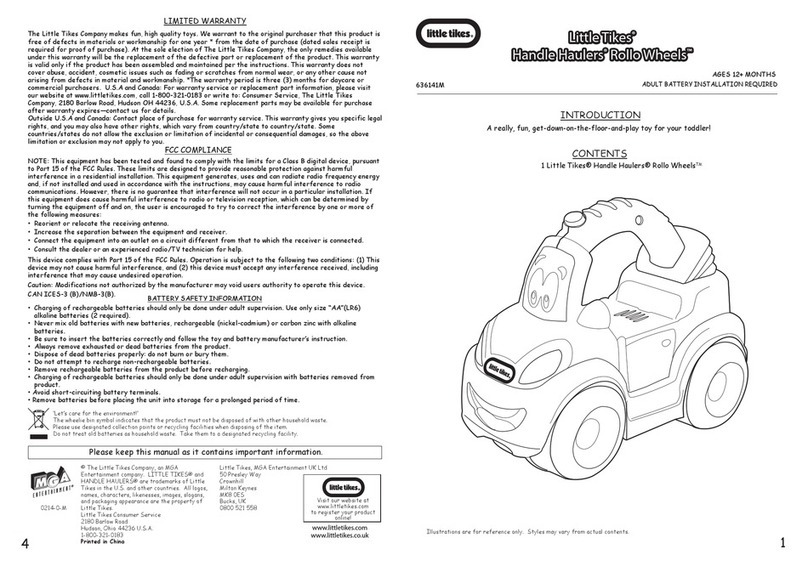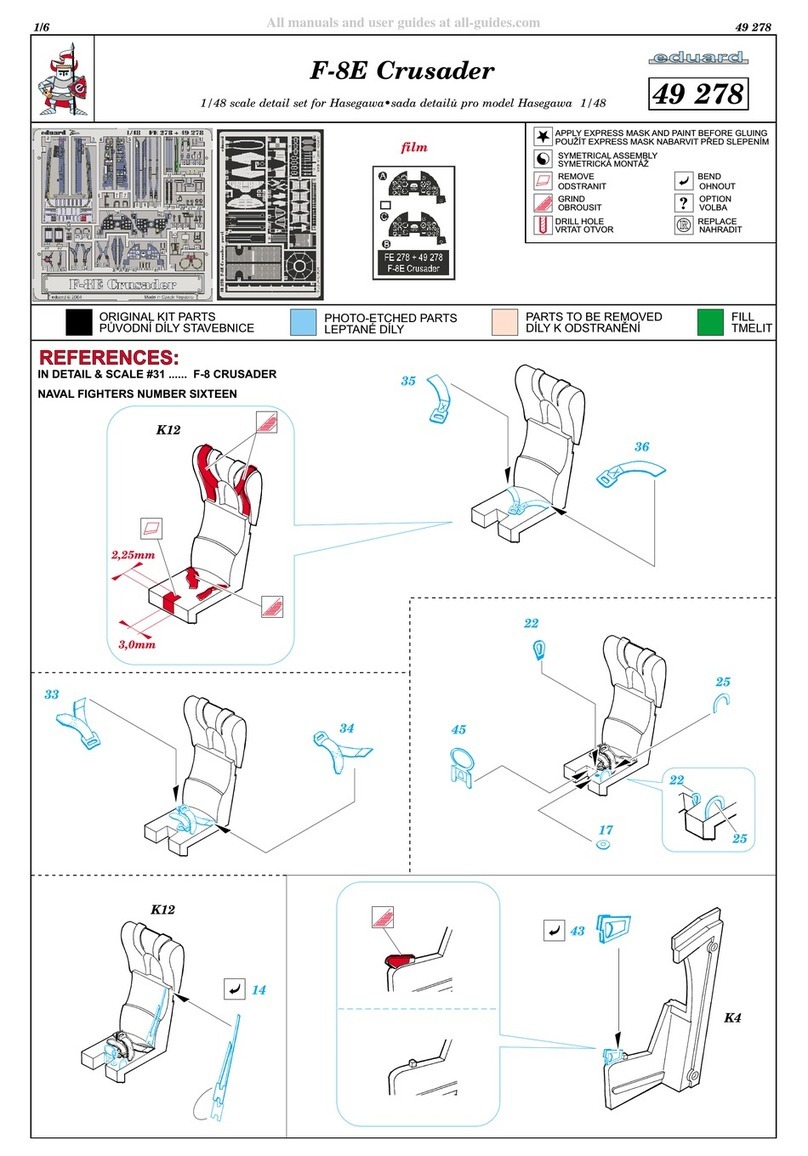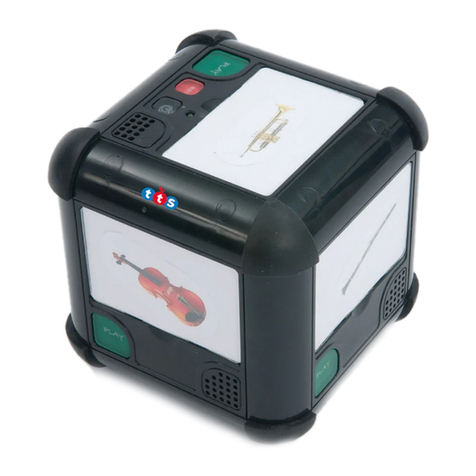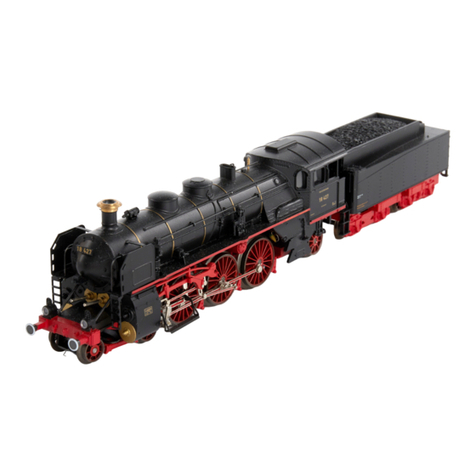
IMPORTANT: Remove tab from battery compartment before use.
The Pretend & Play
®
Calculator Cash Register encourages children to learn basic maths and
calculator skills while it enhances imaginary play. This unique educational toy features
a working calculator that will familiarize children, from preschool age upwards, with
calculator functions. The large buttons on the keypad are easy for little fingers to press and
the cash drawer holds realistic notes and coins.
Children will naturally learn to add and subtract when they use the Calculator Cash Register
for pretend play, selling products in their “shop,” ringing up purchases and giving change.
Calculator features:
• Calculator runs on solar power
• Extra-large buttons for small fingers to manipulate
• An eight-digit display
• Error function to show entry mistakes
• Repetitive equal sign for multi-item purchases
• Negative function for teaching integers
• Student-entered order of operations for learning skills
Preschool Children
Preschool children will appreciate the realism that the working calculator adds to
imaginative play. Although they are not developmentally ready to fully utilize all of the
calculator features, playing with the Calculator Cash Register will familiarize them with the
keys and numerals on the calculator.
Calculator Activities
Numerals 1 through 9
Enter the number 1, and show children the digit on the
display. Then have children enter the number. Repeat with
other numbers. Demonstrate how children can enter
numbers larger than 9. Call out a number for children to
enter on the calculator.
Counting Pennies
Count out pennies from the cash drawer. Encourage children to enter the number of
pennies that you count out. With practice, children will be able to enter the amount of
pennies that they have counted themselves.
Beginning Addition
Use the calculator for beginning addition. Use pennies, blocks or other counters to help
children visualize the addition process. Group counters into piles that are less than ten.
Count one pile and enter its total into the register. Count the other pile and add it to the
first. Show children how the calculator added the two piles together. Push the counter piles
together and check the calculator’s addition.
School-Age Children
School-age children are ready to begin working with the calculator. Use the calculator to
reinforce basic maths facts, not replace them.
How Many?
Use the multiplication feature of the calculator to determine how many fingers there are in
the classroom. Count the children in the room and multiply by ten. Use the same method to
calculate how many eyes there are in the classroom.
How Old are We?
Use the calculator to add the ages of everyone in the classroom.
Let’s Go Shopping!
You need:
- Calculator Cash Register - Play foods
- Money - Shopping bags
- Empty grocery boxes and containers - Coupons
To play:
Create a “supermarket” by arranging products on shelves, the floor, on tables or even on
a row of chairs! Put prices on items for sale. (Keep prices in the single digits for young
children. Use double digits and notes for older children.) Make a shopping list and use
coupons. Encourage children to take turns being shoppers or the check-out person. Both
jobs are fun!
Use language to reinforce learning as you play: “Oh, you’ve bought 5 cans of peas!” or
“I’m sorry, you gave me less money than I need. Could I please have a pound more?” Don’t
limit your language to real life; use your imagination! This can be very entertaining (and
educational) for all ages.
Shoe Shop
You need:
- Calculator Cash Register - Money
- Assorted men’s, women’s, children’s and babies shoes - Ruler
To play:
Help children set up a shoe shop! Jumble shoes into a pile and let the children
sort them into pairs and arrange them by size. Place the shoes on the floor or on shelves
for viewing. Suggest prices for shoes based on their appearance and type. (Use single-digit
whole pound amounts for younger children and larger denominations for older children.)
Encourage children to take turns being customers, salespeople or the check-out person.
Measure children’s feet with a ruler. You may want to make a chart to record foot size.
The fit of the shoes is not as important as the opportunities for language enrichment and
number reinforcement: “Those shoes are too big!” or “I think these shoes are too small for
you, but they might fit your baby sister.” Children will appreciate your humour as you try to
wear a pair of shoes that is obviously too small or too large. Help the check-out person to
total the amount owed and give change.
Lunch Time!
You need:
- Calculator Cash Register - Money
- Magazine photos of food or children’s - Paper plates
drawings of their favourite foods
To play:
Set up a cafeteria! Price food items with realistic values. For example, drinks and desserts
should cost less than main courses. Arrange the food on a long table. Children can select
their food, put it on their paper plates, and pay at the cash register.
All Aboard!
You need:
- Calculator Cash Register - Tickets - Local map
- Money - Row of chairs
To play:
Create a train station! Use the map to decide where your railway will go. Plot the route for
the imaginary train and make tickets with prices based upon destinations!
Decide who will be passengers and who will be the ticket seller, the conductor and the
driver. Children may want to have attendants who pass out snacks or magazines. Let their
imaginations make up the play.
Weigh it, Stamp it, Post it!
You need:
- Calculator Cash Register - Small boxes wrapped in brown paper
- Money - Scale for weighing letters and packages
- Envelopes from opened post - Rubber stamps
- Old stamps or stickers - Pretend postbox
To play:
Children love to send and receive post, and they will really enjoy creating their own
post oce! There are letters to be written, stamps to be purchased, change to be given,
packages to weigh and deliver; it’s a game that can incorporate reading, writing and maths!
Encourage children to create their own roles. Some children might want to write letters or
notes that need to be weighed, stamped and delivered. Create prices for various services:
for example, extra-speedy delivery will cost more. Make sure that all children receive some
post.
Care and maintenance:
• No assembly is required.
• Periodic cleaning with a clean, dry cloth is recommended.
• Store at room temperature.
• Do not expose to moisture, heat or direct sunlight.
Activity Guide
Guía de actividades • Guide d’activités • Spielvorschläge
Calculator
Cash Register
Caja registradora calculadora
Caisse enregistreuse calculatrice • Spielkasse mit Rechenfunktion
Battery Care and Maintenance Tips:
• The beeping sound for the calculator is powered by a 1.5V (G13/LR44) button-
cell battery (included).This battery does not affect the calculator functions.
Should the beeping sound stop working, replace the battery as shown here.
• Insert one new 1.5 V (G13/LR44) button cell or equivalent. Make sure the positive
(+) pole of the battery faces up (as indicated on the battery compartment of the
cash register). Use onlythe type of battery specified here.
• Be sure to insert batteries correctly (with adult supervision) and always follow
the toy and battery manufacturer’s instructions.
• Do not mix alkaline, standard (carbon-zinc), or rechargeable (nickel-cadmium)
batteries.
• Insert batteries with the correct polarity.
• Do not recharge non-rechargeable batteries.
• Only charge rechargeable batteries under adult supervision.
Cuidado de las pilas y consejos de mantenimiento:
• El sonido de la calculadora se emite gracias a una pila de botón de
1,5 V (G13/LR44) (incluida). Esta pila no afecta a las funciones de la calculadora.
Si el juguete deja de emitir el sonido, sustituye la pila tal y como se indica
a continuación.
• Introduce una pila de botón nueva de 1,5 V (G13/LR44) o equivalente. Asegúrate
de que la pila está colocada de modo que el polo positivo (+) esté boca arriba
(tal y como se indica en el compartimento de las pilas de la caja registradora).
Usa solo el tipo de pila que se especifica.
• Asegúrate de insertar las pilas correctamente con la supervisión de un adulto
y sigue siempre las instrucciones del fabricante del juguete ylas pilas.
• No mezcles pilas alcalinas, estándar (zinc-carbono) o recargables
(níquel-cadmio).
• Inserta las pilas con la polaridad correcta.
• No recargues pilas no recargables.
Conseils d’entretien et de maintenance des piles :
• Les bips sonores de la calculatrice sont alimentés par une pile bouton de 1,5V
(G13/LR44) (incluse). Cette pile n’affecte pas les fonctions de la calculatrice. Si
les bips sonores ne sont plus émis, changer la pile comme indiqué ici.
• Insérer une nouvelle pile bouton de 1,5 V(G13/LR44) ou équivalente. Veiller à ce
que le pôle positif (+) de la pile soit dirigé vers le haut (comme indiqué dans le
compartiment des piles de la caisse enregistreuse). Utiliser uniquement le type
de pile spécifié dans ce guide.
• Insérer les piles correctement (sous la supervision d’un adulte) et toujours suivre
les instructions du fabricant du jouet et des piles.
• Ne pas mélanger les piles alcalines, standard (carbone-zinc) ou rechargeables
(nickel-cadmium).
• Insérer les piles en respectant la polarité.
• Ne pas recharger les piles non rechargeables.
• Charger uniquement les piles rechargeables sous la supervision d’un adulte.
Tipps zur Batteriepflege und Wartung:
• Der Piepton für die Kassewird von einer 1,5 V (G13/LR44) Knopfzellen-
Batterie betrieben (enthalten). Die Batterie beeinflusst nicht die
Rechenfunktionen. Bei Nachlassen des Pieptons wird die Batterie wie
nachstehend dargestellt ausgetauscht.
• Setzen Sie eine neue 1,5 V (G13/LR44) Knopfzelle oder eine gleichwertige
Batterie ein. Achten Sie darauf, dass der positive (+)
Pol der Batterie nach oben zeigt (wie auf dem Batteriefach der Spielkasse
dargestellt). Verwenden Sie nur die hier aufgeführten Batterietypen.
• Die Batterien müssen unter Aufsicht eines Erwachsenen eingesetzt
werden. Beachten Sie immer die Anweisungen des Spielgeräte- und
Batterieherstellers.
• Nicht Alkaline-, herkömmliche (Zink-Kohle) undwiederaufladbare (Nickel-
Cadmium) Batterien zusammen verwenden.
• Beim Einsetzen der Batterien auf die richtige Ausrichtung der Pole achten.
• Remove rechargeable batteries from the toy before charging.
• Only use batteries of the same or equivalent type.
• Do not short-circuit the supply terminals.
• Always remove weak or dead batteries from the product.
• Remove batteries if product will be stored for an extended period of time.
• Store at room temperature.
• Do not mix new and used batteries.
• Replace batteries at the first sign of erratic operation.
• Please retain these instructions for future reference.
WARNING: Dispose of used batteries immediately. Keep new and used
batteries away from children. Ifyou think batteries might have been swallowed
or placed inside any part of the body, seek immediate medical attention.
• Carga las pilas recargables solo bajo la supervisión de un adulto.
• Retira las pilas recargables del juguete antes de recargarlas.
• Usa solo pilas de la misma clase o equivalentes.
• No cortocircuites los terminales de corriente.
• Quita siempre las pilas agotadas o casi agotadas del producto.
• Quita las pilas si vas a guardarel producto durante mucho tiempo.
• Guarda la unidad a temperatura ambiente.
• No mezcles pilas nuevas y viejas.
• Sustituye las pilas ante la primera señal de funcionamiento errático.
• Guarda estas instrucciones para futuras consultas.
ATENCIÓN: Desechar las pilas usadas de inmediato. Mantener las pilas
nuevas yusadas fuera del alcance de los niños. Si se sospecha que las pilas
han sido ingeridas o introducidas en cualquier parte del cuerpo, buscar
atención médica inmediata.
• Retirer les piles rechargeables du jouet avant de les charger.
• Utiliser uniquement des piles du même type ou de type équivalent.
• Ne pas court-circuiter les bornes d’alimentation.
• Toujours retirer les piles faibles ou déchargées du produit.
• Retirer les piles si le produit ne va pas être utilisé pendant une longue période
de temps.
• À conserver à température ambiante.
• Ne pas mélanger les piles neuves et usagées.
• Remplacer les piles aux premiers signes de dysfonctionnement.
• Veuillez conserver ces instructions pour toute référence ultérieure.
ATTENTION : Éliminez immédiatement toutes les piles usagées. Conservez les piles
neuves et usagées hors de la portée des enfants. Si vous pensez que des piles ont
pu être avalées ou insérées dans toute partie du corps, consultez immédiatement
un médecin.
• Nicht versuchen, nichtaufladbare Batterien aufzuladen.
• Wiederaufladbare Batterien nur unter Aufsicht Erwachsener aufladen.
• Wiederaufladbare Batterien vor dem Aufladen aus dem Spielgerät entnehmen.
• Nur Batterien desselben oder eines geeigneten Typs verwenden.
• Anschlüsse nicht kurzschließen.
• Entfernen Sie schwache oder leere Batterien immer aus dem Produkt.
• Entfernen Sie die Batterien, falls das Produkt für längere Zeit weggeräumt wird.
• Bei Zimmertemperatur lagern.
• Nicht neue und alte Batterien zusammen verwenden.
• Batterien wechseln, sobald ersteAnzeichen einer unregelmäßigen Funktion auftreten.
• Bewahren Sie diese Anleitung bitte gut auf.
ACHTUNG: Verbrauchte Batterien sofort entsorgen. Neue und verbrauchte Batterien
für Kinder unzugänglich aufbewahren. Falls Sie vermuten, dass Batterien verschluckt
wurden oder sich im Körperinneren befinden, wenden Sie sich sofort an einen Arzt.
LSP 2629-UK • LSP 2629-EUR
3+
ages
años
ans
jahre
© Learning Resources Ltd., Bergen Way,
King’s Lynn, Norfolk, PE30 2JG, UK
Learning Resources, Inc., Vernon Hills, IL, US
Please retain the package for future reference.
Made in China. LRM2629-UK-GUD
Hecho en China. Conserva el envase para
futuras consultas.
Fabriqué en Chine. Veuillez conserver l’emballage.
Hergestellt in China. Bitte Verpackung gut aufbewahren.
Learn more about our products
at LearningResources.co.uk
TOP




